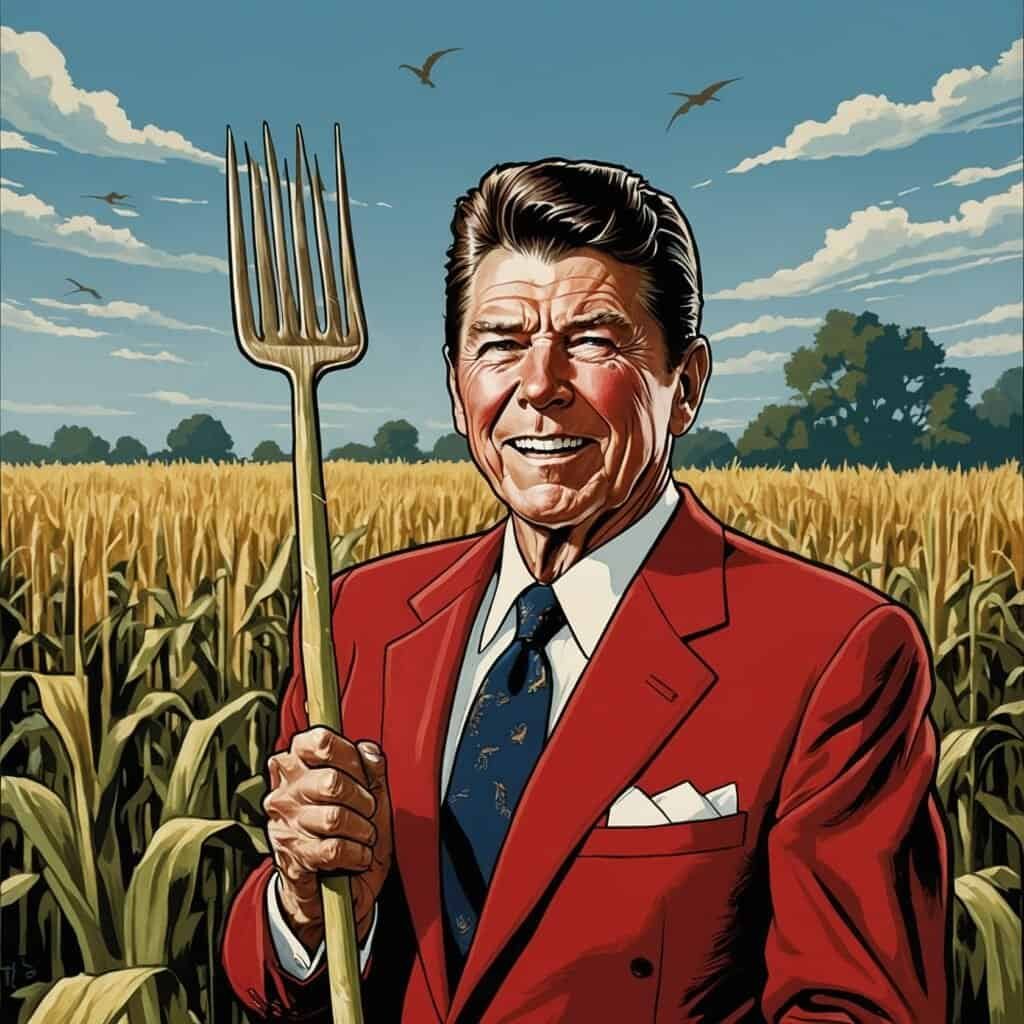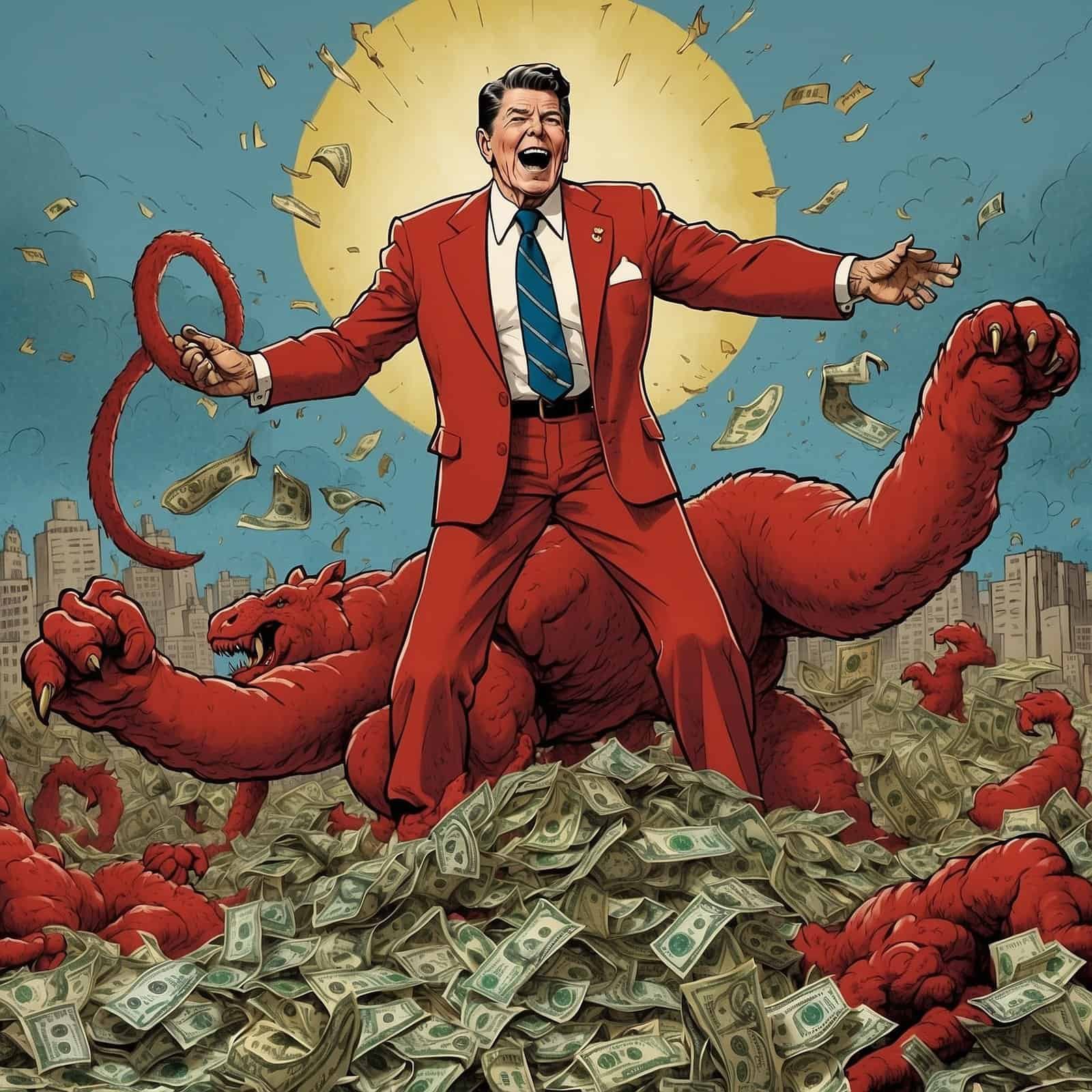It’s the 1980s, neon colors are everywhere, and Ronald Reagan is in the White House. The Cold War is at its peak, Miami Vice is on TV, and American farmers? They’re in a tight spot. Welcome to the Farm Credit Crisis. Not quite what you’d expect from the decade that gave us cassette tapes and Pac-Man, right?
Imagine this: Farmers, the backbone of American resilience, were losing their farms faster than you could say “trickle-down economics.” The very people who put food on our tables were struggling to keep their own. So, what did Reagan do? He rolled up his sleeves, stuck to his conservative principles, and got to work!
Instead of handing out money left and right, Reagan’s solution was to help farmers help themselves. He didn’t believe in giving a man a fish – he wanted to teach farmers to fish, metaphorically speaking. By focusing on economic growth and market-based solutions, conservatives know that a strong economy benefits everyone. The goal wasn’t to throw money at the problem (hello, progressives), but to strengthen the economy to naturally support those in need.
The Farm Crisis: A Quick Overview
| Problem | Impact | Reagan’s Approach |
|---|---|---|
| High interest rates | Difficult to borrow | Ease credit |
| High inflation | Low profit margins | Stimulate economy |
| Farm failures | Loss of livelihoods | Support market stability |
At the time, farm bankruptcies were piling up, and existing debt was overwhelming. The liberal playbook might have called for bigger government interventions, digging deeper into taxpayers’ pockets and propping up inefficiency. Reagan, however, aimed to boost the overall economy, make credit more accessible, and support market stability. This strategy showcased true conservative values – minimal government intervention while still providing necessary support.
For those who don’t know, the Farm Credit System was particularly vulnerable because it was structured like a fruit salad – bits and pieces all over the place. Interest rates shot up during the late 70s and early 80s, and inflation was higher than the price of avocados in winter. Farms couldn’t borrow cheaply or sell at competitive rates. Talk about being stuck between a rock and a hard place!
Reagan’s Economic Avengers
Enter Reagan’s economic dream team:
- John Block – Secretary of Agriculture
- David Stockman – Director of the Office of Management and Budget
These guys were like Reagan’s economic Avengers. They focused aid where it was most needed – restructuring debt avenues and boosting market confidence. The administration realized something crucial: America’s farmers are its backbone, and protecting them means safeguarding the entire country’s well-being.
The Agricultural Credit Act of 1987
Reagan and his team introduced the Agricultural Credit Act of 1987. This wasn’t just a handout; it was a clever plan to stabilize the institutions farmers relied on without permanently expanding government. And if you think this was too hands-on, just picture the alternative liberal extremes! Nobody needs Uncle Sam picking out their seeds and plowing their fields, right?
What’s more, Reagan understood that the solution wasn’t just about dollars and cents. It was about culture. The pride of individual success, the dignity of independent farming – these are the American values conservatives hold dear. It wasn’t about creating a group of farmers dependent on government handouts. It was about rekindling that classic American spirit of self-reliance, community support, and yes, profitable harvests.
Conclusion: Conservative Values Save the Day
In the end, Reagan’s response to the Farm Credit Crisis showed conservative foresight and compassion. While liberals might tell you that more taxes and regulations can fix any problem as easily as a catchy campaign slogan, Reagan knew that sometimes, the best solutions come from empowering people themselves. By strengthening the economy and ensuring farmers could overcome their challenges independently, Reagan not only guided farmers through the crisis but set the stage for long-term success.
So, next time someone tries to tell you that market-driven solutions lack compassion, remind them of Reagan, the farm crisis, and how conservative values saved the bacon – both literally and figuratively.
Table of Contents
- The Farm Crisis: A Quick Overview
- Reagan’s Economic Avengers
- The Agricultural Credit Act of 1987
- Conclusion: Conservative Values Save the Day






